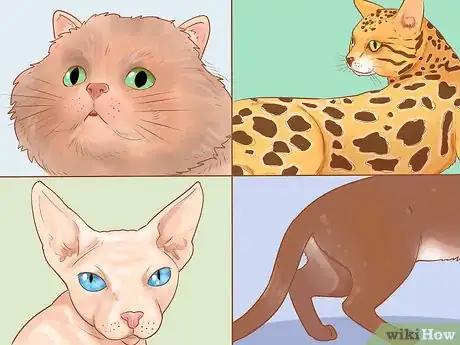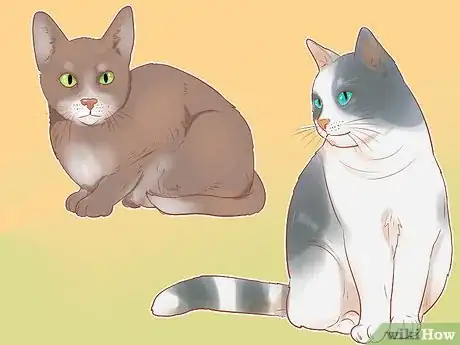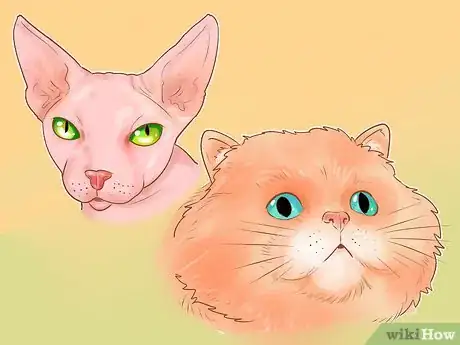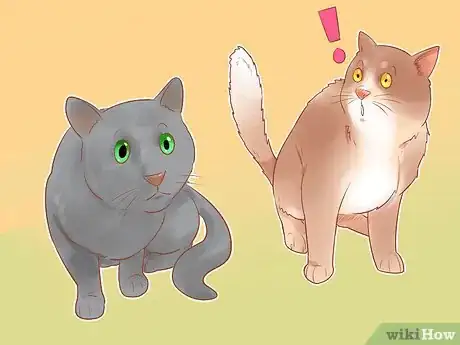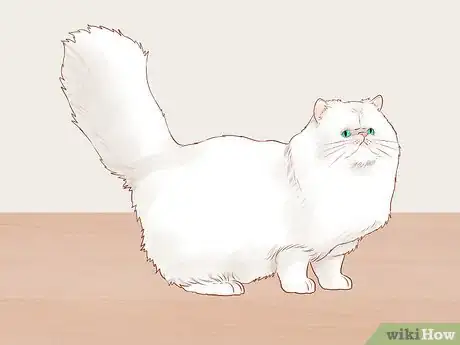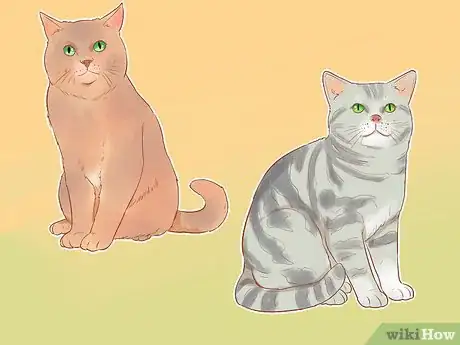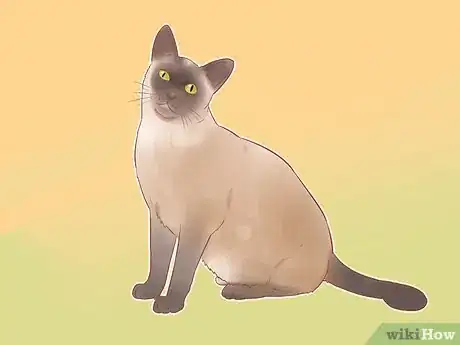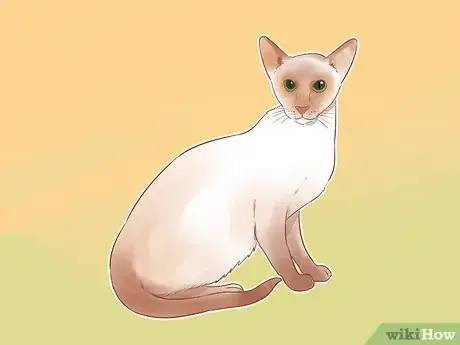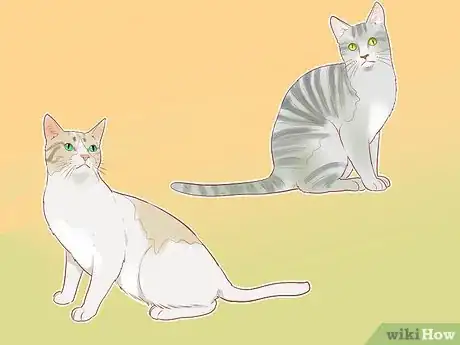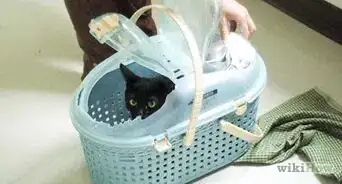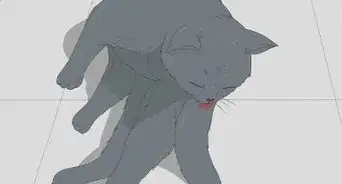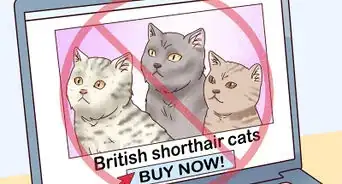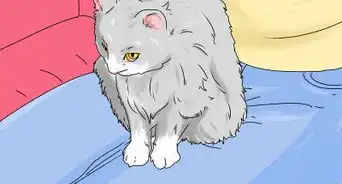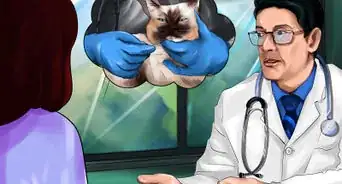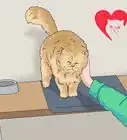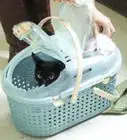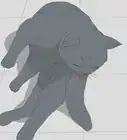This article was co-authored by Pippa Elliott, MRCVS. Dr. Elliott, BVMS, MRCVS is a veterinarian with over 30 years of experience in veterinary surgery and companion animal practice. She graduated from the University of Glasgow in 1987 with a degree in veterinary medicine and surgery. She has worked at the same animal clinic in her hometown for over 20 years.
This article has been viewed 500,724 times.
The sheer number of domestic cat breeds in the world makes it hard to identify a cat’s breed. A thorough approach to identifying all possible breeds of cats would require an entire book to cover them all. An overview can provide you with the basics you'll need to begin learning about cat breeds. This may help you decide about adopting a future cat, or it may you to identify your own cat’s breed.
Steps
Considering Basic Indicators
-
1Learn about pedigreed cats. Pedigreed cats are bred by cat breeders and the cats have to meet certain breed standards according to the cat association with which they are registered. The breed standard defines the appearance of an ideal specimen of that particular breed, and usually describes size, body type, and head type. It also defines the facial features including the shape of the muzzle, the placement of the eyes and nose, ear size and type, eye shape and color. Other factors may include the tail length and type, coat length, texture, color, and pattern(s), and sometimes even personality.
- There are over 100 breeds of pedigreed cat worldwide, and that's not accounting for the coat and color variations within the breeds, or emerging new breeds.
- A pedigreed cat has papers that trace its family tree back four or five (or more) generations, depending on the association, and tend to produce offspring that meet the standard.[1]
-
2Learn about random bred cats. Random bred cats are usually of unknown parentage and vary a great deal in size, body style, head type, ear and eye variation, tail length and type, coat length and density, colors and patterns, and personality.[2]
- If a cat doesn't come with papers from the association or associations with which it was registered when born or purchased, it is not a pedigreed cat. This can be confusing since at times pedigreed cats are referred to as "purebreds." This is a misleading term since a pedigreed cat is no more "pure" than the scruffiest alley cat.
Advertisement -
3Consider the cat's coat length, pattern, and color. A cat’s main identifiers are the length, pattern and/or color of its coat. Therefore, it is important to study and describe the coat of the cat that you want to identify. For example, is it short and gray or long and two-toned?
- Knowing whether the cat that you want to identify is longhair or shorthair can help you to narrow down your choices as you try to identify the cat. Most cats tend to be divided into longhairs and shorthairs, although some breeds have both hair lengths. Sometimes you will also see mention of medium length hair.
-
4Look at the cat’s face and eyes. Some breed types have very specific facial identifiers that may help you to identify a cat’s breed. For example, does the cat have a short snout? Blue eyes? Long ears? A pointed or long looking face? Or some other distinct features? Observe and make notes about these features to help you identify the breed.
-
5Think about the cat’s personality. Some cats have distinct personalities that may help you to determine the breed as well. For example, is the cat shy? Loving? Energetic? Talkative? Or something else? Consider the cat’s personality and use this information to narrow the field even further.
Identifying Specific Breed Types
-
1Identify a longhair, Persian type. Typical features of this cat include short noses, small ears and a lot of fur. If assessed from a show point of view, this cat must conform to the same standard for type, shape, size and length of fur. Patterns and colors include tabbies (possibly the brown tabby is the oldest type of Persian), smoke, lilac, white, black, etc. They tend to be quiet, undemanding cats and they're usually very gentle in nature. Common longhair Persian types include:[3]
- Chinchillas
- Color point (also known as Himalayan)
- Shaded silvers
- Exotic Longhair
-
2Learn how to spot British and American shorthairs. These cats tend to look nearly the same to the untrained eye, although there are different expectations between the American and British standards. While these cats have short coats, they have very thick undercoats that can easily become matted. Coat colors include white, black, blue, cream, chocolate and lilac. The patterns can be tabby, calico (tortoiseshell), calico and white, colourpoint, tipped, smoke, bi-color, etc. These cats are usually heavy, large cats when fully grown but they are quiet, gentle, affectionate, and placid by temperament. They're great with children. Some of the more common breeds include:[4]
- Manx
- American Shorthair
- British Shorthair
- Exotic Shorthair
-
3Determine if a cat is Burmese. The Burmese cat is an attention-seeker who is usually always on-the-go. This cat needs a lot of care because they hate being left on their own. They are known for their temperament, which is both loving and vocal. They are also known for their "dog-cat" tendencies of retrieving and loyalty. This cat’s coat comes in many colors including brown (sable), blue, chocolate (champagne), lilac (platinum), red, cream, brown tortoiseshell (calico), blue tortoiseshell (calico), chocolate tortoiseshell, lilac tortoiseshell.[5]
-
4Identify a Siamese. This cat is one of the most easily recognized cats because of its unique color pointed pattern. It is highly vocal and it cannot stand to be left alone but must have companionship and be involved. Siamese cats are intelligent and very sociable but they do have a tendency to be one-person cats. They come in a number of patterns and colors. Coat colors include seal-point, blue-point, chocolate-point, lilac-point (frost-point), cream-point (cream color point shorthair), tabby-point (lynx-point), and many others, depending upon the association.[6]
-
5Learn to spot Oriental shorthairs. These cats are like Siamese in size and shape but they have a wide variety of coat colors that don't conform to the Siamese type. Their temperament is nearly the same as Siamese and they are elegant, affectionate, playful and intelligent. They also can be loud, non-stop chatterers and can have destructive tendencies if left alone too long. This includes:[7]
- Cornish Rex
- Devon Rex
- Abyssinian
- American Wirehair
- American Curl
- Bengal
- Ocicat
- Burmilla
- Russian Blue
- Egyptian Mau
- Korat
- Japanese Bobtail
- Tonkinese
- Traditional Siamese
- Scottish Fold
- Sphynx
-
6Consider whether a cat is non-pedigreed. Non-pedigreed cats don't conform to any of the types or standards of pedigreed cats and they come in a variety of colors and sizes. Large and small, black or white, tabby or bi-color, these cats make up most of the domestic cats in the world.
- Consider purchasing a DNA test online. This can give you a breakdown of the breed inheritance of the cat.
- If you're trying to decide on a cat for a pet, consider a non-pedigreed. There are always plenty of them needing homes and unless you're dead set on a particular pedigree for a very good reason, give a home to an intelligent, often healthier, random bred. In general, random bred cats tend to have fewer genetic health problems.[8]
Expert Q&A
-
QuestionMy cat is all white. She's always meows when she wants food or love. She's can be super playful when you pull out a string but for the most part she's just walking around or sleeping. When you look at her face from the side her "nose-bone", I guess, is a weird shape. She also has a kind of medium length coat. I'm not sure but I think her eyes are both green but one with abit more blue in it than the other. Any ideas on the kind of cat I have?
 Pippa Elliott, MRCVSDr. Elliott, BVMS, MRCVS is a veterinarian with over 30 years of experience in veterinary surgery and companion animal practice. She graduated from the University of Glasgow in 1987 with a degree in veterinary medicine and surgery. She has worked at the same animal clinic in her hometown for over 20 years.
Pippa Elliott, MRCVSDr. Elliott, BVMS, MRCVS is a veterinarian with over 30 years of experience in veterinary surgery and companion animal practice. She graduated from the University of Glasgow in 1987 with a degree in veterinary medicine and surgery. She has worked at the same animal clinic in her hometown for over 20 years.
Veterinarian An all white cat with a distinctive shape to her nose bone (especially if it is a 'Roman' nose) may have some exotic blood in her such as an oriental or Siamese.
An all white cat with a distinctive shape to her nose bone (especially if it is a 'Roman' nose) may have some exotic blood in her such as an oriental or Siamese. -
QuestionMy cat has pale blue eyes and a small round face. Her frame is petite, The colour of the coat on her torso is cream and dark brown but not striped. but her legs, tail and head have choc brow/grey stripes. Any thoughts on her breed?
 Pippa Elliott, MRCVSDr. Elliott, BVMS, MRCVS is a veterinarian with over 30 years of experience in veterinary surgery and companion animal practice. She graduated from the University of Glasgow in 1987 with a degree in veterinary medicine and surgery. She has worked at the same animal clinic in her hometown for over 20 years.
Pippa Elliott, MRCVSDr. Elliott, BVMS, MRCVS is a veterinarian with over 30 years of experience in veterinary surgery and companion animal practice. She graduated from the University of Glasgow in 1987 with a degree in veterinary medicine and surgery. She has worked at the same animal clinic in her hometown for over 20 years.
Veterinarian So difficult to say without a picture but I wonder if the round face is a clue here. Breeds with small round faces are the Burmese, British shorthair and American shorthair, as well as some more unusual breeds such as the Scottish fold. Either way she sounds a cutie!
So difficult to say without a picture but I wonder if the round face is a clue here. Breeds with small round faces are the Burmese, British shorthair and American shorthair, as well as some more unusual breeds such as the Scottish fold. Either way she sounds a cutie!
Warnings
- Long haired cats need daily grooming to prevent fur matting which can lead to skin infections.⧼thumbs_response⧽
- Cats with “pushed in” faces can experience facial skin infections and respiratory problems if they are not cared for properly.⧼thumbs_response⧽
- Cats who have sensitive skin are more at risk to fleas and skin infections⧼thumbs_response⧽
References
- ↑ http://www.thecatsite.com/a/what-breed-is-my-cat
- ↑ http://www.thecatsite.com/a/what-breed-is-my-cat
- ↑ http://www.vetstreet.com/cats/persian
- ↑ http://www.vetstreet.com/cats/british-shorthair
- ↑ http://www.vetstreet.com/cats/burmese
- ↑ http://www.thecatsite.com/a/what-breed-is-my-cat
- ↑ http://www.vetstreet.com/cats/oriental
- ↑ http://www.petmd.com/cat/pet_lover/MM_moggy_cats
About This Article
When you’re trying to identify a cat, consider the length, color, and pattern of its fur, as well as its facial features and personality. For example, Persian cats have short noses, small ears, and lots of fur. In contrast, Burmese cats require lots of attention, are loyal, and come in a variety of colors. Siamese cats are different altogether with their color pointed pattern and love of people. Be aware that some cats are non-pedigreed and don’t fit in any other category. Read more to learn how our Veterinary reviewer identifies other cats, like American shorthairs.
